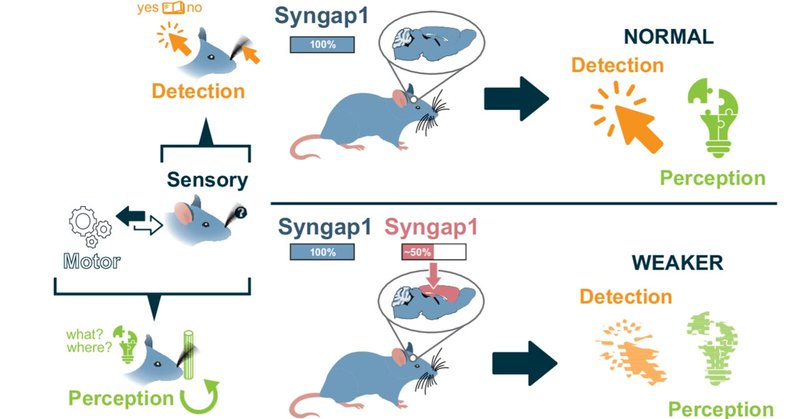
Gavin Rumbaugh
@GavinRumbaugh
Followers
785
Following
514
Media
83
Statuses
438
Neuroscientist @ScrippsResearch, Neurodevelopmental disorder risk genes & impact on brain function, High throughput phenotypic screens for rare brain disorders
Jupiter, FL
Joined November 2018
Research from @UFScripps shows an autism-linked gene called Syngap1 enables touch-based perception, while certain mutations can lead to mixed signals. #braindevelopment #neuroscience #autism
https://t.co/xOIRfjpNyb
0
2
4
New paper from providing insight into how a gene variant that causes cognitive impairment (Syngap1 haploinsufficiency) does so through impairing how sensory and motor signals converge in cortex to support perception and adaptive behavior. @cureSYNGAP1
https://t.co/hdKo7j68Nw
nature.com
Nature Communications - Whether and how highly penetrant NDD (neurodevelopmental disorder) genes such as Syngap1 regulate sensorimotor integration are not fully understood. This study shows that...
1
8
28
📢 Our latest paper is out in @CellCellPress! Led by the multi-talented @XinheZheng, we accelerated AAV-based gene delivery to 2 days & enabled in vivo CRISPR screens with single cell-level readout, a leap from existing capabilities 🤯 How does it work? (1/8)
52
194
1K
5yr goals: 1) maximize brain penetrance and minimize toxicity of the lead compound; 2) perform additional screening to identify more leads that raise SynGAP; 3) demonstrate optimized leads reverse in vivo phenotypes. 4) declare a preclinical candidate for advance drug development
0
0
7
small molecules that boost expression of genes that regulate cognitive function have advantages: 1) they can in theory target both genetic and non-genetic cognitive disorders; 2) they are based on small molecules - so doses can be adjusted daily, perhaps improving safety. (4/5)
2
0
4
Boosting SynGAP in wt mice protects from seizure and enhances cognition, suggesting that these small molecules may improve NDDs without a genetic cause. https://t.co/deZJOK9qRX ***our long-term goal is to find treatments for cognitive impairment for common (non-genetic) NDDs***
elifesciences.org
Alternatively spliced C-terminal protein sequences encoded by the Syngap1 gene exhibit unique biochemical and functional properties in vivo, which explain in part how individual isoforms can promote...
1
0
1
Using our platform, NDD-Chemscreen, we identified drug-like small molecules that raise endogenous SynGAP protein expression in either WT or Syngap1 heterozygous neurons. The later models SYNGAP1-DEE, and so these compounds address the root cause of the genetic disorder. (2/5)
1
0
4
Received an $8.2M U01 program project from NIMH to modify lead compounds for the treatments of a genetic disorder defined by comorbid ID, Epilepsy, and ASD (SYNGAP1-DEE). These compounds are also expected to improve cognition in common neuropsychiatric disorders. (1/5)
11
4
70
Very good to see this very large study countering strong claims that maternal infection increases risk of autism in offspring. They found no evidence of an association.
Findings "strongly imply that there is no specific link between maternal mental illness or maternal infection during pregnancy" & neurodevelopmental disabilities (including autism) in offspring https://t.co/ja8N4C0Cp7 free
1
9
39
Surprise visitor at the beach today. Hmm, do we have some mEPSC experiments to do….🤫?
0
0
8
Hung out with this little guy this morning while sorting my thoughts. Late-season surprise! He looks strong - I think he’ll make it.
0
0
13
These integrated signals are also known to enable computations that promote an understanding of object features, such as texture and location (O’Connor et al., 2021). Together, a candidate mechanism that explains impaired touch-related perception in Syngap1 heterozygous mice.
0
0
1
2) Integrates touch signals with motor-related signals that carry whisker-object location information. Integration of sensory and motor signals in cortex is a known mechanism that engages attentional processes that sustains whisker-object exploration (Sherman et al., 2017).
1
0
1
1) Promotes coding of touch-dependent information within cortex. A mechanism that explains broadly reduced tactile detection sensitivity in Syngap1 heterozygous mice.
1
0
0
In conclusion - expression of Syngap1 in cortical excitatory neurons promotes 2 synergistic processes that lead to understanding (e.g., perception) of the external world (object):
1
0
0
So these mice have a network that poorly encodes meaningful object touches in the context of overrepresented whisker motion signals. Not a good situation for registering salient touch events and integrating them with the location of body parts... A correlate of poor attention?
1
0
0
In contrast, during object touches, LESS activity was generated across the higher order network in Syngap1 mice. In fact, the STRONGER the touch (as measured by whisker curvature), the LESS activity was generated. This is opposite to WT mice (stronger touch = more activity).
1
0
0
Before touch occurs, whisker movement must be initiated. But because of our design, whisker movement was not always accompanied by object touches. Finding - Neuronal activity during pure whisker motion was ELEVATED across the higher-order touch network. Related to epilepsy?
1
0
0
No change in global neural activity in this network over 2hrs in the mutant mice. However, because we had high-speed video of whisker movement before and during object exploration, we could look at distributed neuronal activity during these specific behaviors.
1
0
0






